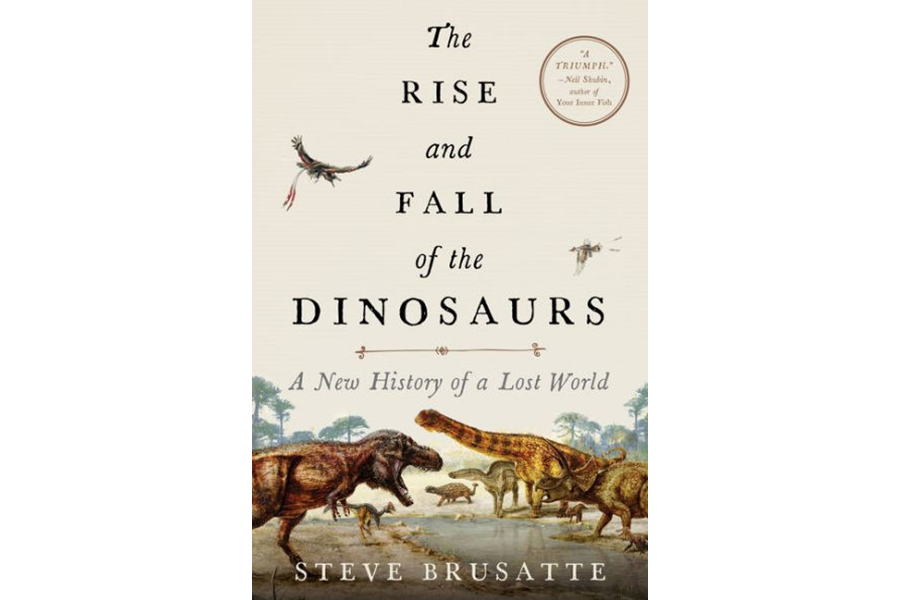'The Rise and Fall of the Dinosaurs' covers millennia of dinosaur dominance
Loading...
Imagine an alien world bristling with life, filled in every one of its regions and climates with bizarre beings, wonderfully complex and colorful creatures of nearly infinite variety, nearly all of whom are doomed.
That alien world is Earth, and Steve Brusatte's new book tells the story of those creatures. The Rise and Fall of the Dinosaurs: A New History of a Lost World takes the great piles of geological and paleontological data and transforms it all into an absorbing historical saga.
The long, long narrative of the dinosaurs begins with a cataclysm and ends with a cataclysm. At the end of the Permian period, 252 million years ago, massive volcanic fissures opened up under Siberia and belched magma, poisonous gases, and ferocious heat for hundreds of thousands of years, setting off what Brusatte describes as a “cascade of destruction” that would last for millions of years and reshape the world. “Descriptions of doom and gloom could go on for pages, but the point is, the end of the Permian was a very bad time to be alive,” Brusatte writes. “It was the biggest episode of mass death in the history of our planet. Somewhere around 90 percent of all species disappeared.”
All the large animals that had roamed Earth for millions of years, the gorgonopsians and dicynodonts and therapsids and all the others, were dealt the kind of death blow that only these “extinction-level events” can produce. Suddenly a broad variety of adaptational niches were vacant.
Thus freed by both climate and opportunity, dinosaurs multiplied and adapted to fill every niche on the planet, and Brusatte tells this story with a comprehensive attention to detail that's reminiscent of 2016's "Dinosaurs: How They Lived and Evolved" by Darren Naish and Paul Barrett – and with even greater narrative exuberance. Brusatte, a paleontologist at the University of Edinburgh and discoverer of (so far) 15 new dinosaur species, skillfully combines interesting and amusing stories from his field experience with the broader story of dinosaurs ruling the Earth.
Of course, long before the dinosaurs, Earth was ruled by microbes for billions of years. This fact has never tempted Steven Spielberg. No, most of our fascination with dinosaurs is connected to how big some of them were. Sauropods in particular grew to absolutely astounding sizes never achieved before or since by land animals of any kind, a fact that long puzzled scientists. Most sauropods, Brusatte notes, “matured from guinea-pig-size hatchlings to airplane-size adults in only about thirty or forty years, an incredibly short period of time for such a remarkable metamorphosis.” The key, it turns out, wasn't merely metabolic but also structural: sauropod bones were strong but hollow, honeycombed with air sacs that not only lightened the skeletal load for creatures the size of double-decker buses but also helped with the all-important task of regulating body heat.
"The Rise and Fall of the Dinosaurs" abounds with this completely winning blend of technical expertise and storytelling ability, following the story of its many subjects into dozens and dozens of subplots as dinosaurs colonized every inch of the land, moved out into the ocean, and even took to the sky. Brusatte's recounting of the millions of years of dinosaur dominance makes for very nerdy, very thrilling reading. But of course the end of that heyday was looming.
Just as the dinosaur story began with a massive planet-transforming cataclysm, so too it famously ended with one: 66 million years ago, so the prevalent theory goes, a massive asteroid struck Earth, sending a choking, light-shrouding cloud of ash into the upper atmosphere, thus altering the climate too quickly for most dinosaurs to adapt – including the most famous dinosaur of all, as Brusatte points out.
“It was the worst day in the history of our planet,” he writes. “A few hours of unimaginable violence that undid more than 150 million years of evolution and set life on a new course … and T. rex was there to witness it.”
In all their great number and variety, they went extinct – with the sole exception of birds, all of which are the descendants of the theropod group of dinosaurs, an idea first popularized in Robert Bakker's terrific 1986 book "The Dinosaur Heresies" and here given a parting nod: “But let's not forget about those birds – they are dinosaurs, they survived, and they are still with us.”








